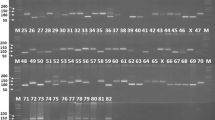Abstract
The genetic structure and diversity of 148 soybean genotypes were analyzed using 26 simple sequence repeat (SSR) markers. SSR analysis showed distinctive polymorphism among the 148 lines. A total of 71 alleles were detected with an average of 2.8 alleles per SSR locus. Polymorphism information content varied from 0.118 to 0.699 with an average of 0.369. These soybean genotypes were divided into 3 subgroups based on STRUCTURE analysis. Further comparison showed that the arithmetic average (UPGMA) and STRUCTURE subgroups in fact were highly coherent, as genotypes in their subsequent classified group exhibited consistency with their origins or pedigree. This analysis provided a deep insight into the genetic structure of soybeans in India and will help us to improve the breeding strategies.





Similar content being viewed by others
References
Almeida RD, Peluzio JM, Afferri FS (2011) Divergência genética entre cultivares de soja, sob condições de várzea. Rev Ciênc Agron 42:108–115
Anderson JA, Churchill GA, Autrique JE, Tanksley SD, Sorrells ME (1993) Optimizing parental selection for genetic linkage maps. Genome 36:181–186
Bisen A, Khare D, Nair P, Tripathi N (2015) SSR analysis of 38 genotypes of soybean (Glycine max (L.) Merr.) genetic diversity in India. Physiol Mol Biol Plants 21:109–115
Bommi P, Ferguson DL (2005) Soybean cultivars Identification within a selected group using only an agarose gel system with simple sequence repeats DNA markers. Soybean Genet Newsl 32:1–7
Chang SH, Teng TT, Ismail N (2011) Screening of factors influencing Cu (II) extraction by soybean oil-based organic solvents using fractional factorial design. J Environ Manage 92(10):2580–2585
Cregan PB, Jarvik T, Bush AL, Shoemaker RC, Lark KG, Kahler AL, Kaya N, VanToai TT, Lohnes DG, Chung J, Specht JE (1999) An integrated genetic linkage map of the soybean. Crop Sci 39:1464–1490
Cunha MCG, Hamawaki OT, Sousa LB (2013) Genetic variability among 79 soybean progenies from UFU breeding program. Biosci J 29:340–349
Excoffier L, Lischer HEL (2010) Arlequin suite ver 3.5: a new series of programs to perform population genetics analyses under Linux and Windows. Mol Ecol Resour 10:564–567
Jain S, Jain RK, McCouch SR (2004) Genetic analysis of Indian aromatic and quality rice (Oryza sativa) germplasm using panels of fluorescently-labeled microsatellite markers. Theor Appl Genet 109:965–977
Liu K, Muse S (2005) Power marker: new genetic data analysis software. Release 3.0. http://powermarker.net; verified 9 September
Narvel JM, Fehr WR, Chu WC, Grant D, Shoemaker RC (2000) Simple sequence repeats diversity among soybean plant introductions and elite genotypes. Science 40:1452–1458
Nei M (1972) Genetic distance between populations. Am Nat 106:283–292
Powell W, Machray GC, Provan J (1996) Polymorphism revealed by simple sequence repeats. Trends Plant Sci 1:215–222
Prevost A, Wilkinson MJ (1999) A new system of comparing PCR primers applied to ISSR fingerprinting of potato cultivars. Theor Appl Genet 98:107–112
Pritchard JK, Wen W (2003) Documentation for STRUCTURE software: Version 2. Available from http://pritch.bsd.uchicago.edu
Pritchard JK, Stephens P, Donnelly P (2000) Inference of population structure using multilocus genotype data. Genetics 155:945–959
Saghai Maroof MA, Soliman KM, Jorgensen RA, Allard RW (1984) Ribosomal DNA spacer—length polymorphism in barley: Mendelian inheritance, chromosomal location and population dynamics. Proc Natl Acad Sci (USA) 81:8014–8018
Song QJ, Marek LF, Shoemaker RC, Lark KG, Concibido VC, Delannay X, Specht JE, Cregan PB (2004) A new integrated genetic linkage map of the soybean. Theor Appl Genet 109(1):122–128
Tomar J, Saini N, Goyal BS, Tripathi N, Shrivastava AN, Verma RK, Tiwari S (2011) Assessment of genetic diversity among Rhizoctonia root rot resistant soybean. J Food Leg 24:267–272
Torres AR, Grunvald AK, Martins TB, Santos MAD, Lemos NG, Silva LAS, Hungria M (2015) Genetic structure and diversity of a soybean germplasm considering biological nitrogen fixation and protein content. Sci Agric 7:47–52
Velusamy V, Lee KJ, Ha BK, Kim JB, Kim SH, Ahn JW, Kang SY, Kim DS (2013) Evaluation of genetic diversity in Korean soybean landraces by protein banding patterns using high-throughput screening. J Crop Sci Biotechnol 16:189–195
Vieira ESN, Schuster I, Silva RB, Oliveira MAR (2009) Variabilidade genética em cultivares de soja determinada com marcadores microssatélites em gel de agarose. Pesq Agropec Bras 44:1460–1466
Acknowledgements
Research was conducted in “Technical Cooperation Project for Maximization of Soybean Production in Madhya Pradesh” supported by Japan International Cooperation Agency (JICA), Japan.
Author information
Authors and Affiliations
Corresponding author
Ethics declarations
Conflict of interest
Authors declare that they have no conflicts of interests.
Additional information
Publisher's Note
Springer Nature remains neutral with regard to jurisdictional claims in published maps and institutional affiliations.
Rights and permissions
About this article
Cite this article
Tiwari, S., Tripathi, N., Tsuji, K. et al. Genetic diversity and population structure of Indian soybean (Glycine max (L.) Merr.) as revealed by microsatellite markers. Physiol Mol Biol Plants 25, 953–964 (2019). https://doi.org/10.1007/s12298-019-00682-4
Received:
Revised:
Accepted:
Published:
Issue Date:
DOI: https://doi.org/10.1007/s12298-019-00682-4




